|
Travel with Us Secular Geographies: European Artists in IndiaThe Editorial Team August 01, 2024 DAG’s new exhibition encompasses the work of a diverse range of artists and travellers who painted their views of India between the years of 1857 and 1947, when the country became independent of colonial rule. This exhibition showcases them as representatives of a later phase of Orientalist art. Unlike earlier landscape painters such as William Hodges, Thomas and William Daniell, whose focus was primarily on capturing picturesque architectural and natural views, the artists of the late nineteenth and early twentieth centuries displayed greater diversity in their interests and were more intrigued by the people, society, and everyday scenes of India rather than solely monumental architecture. Stylistically, they exhibited a wide range of approaches, reflecting influences from various countries including Germany, Holland, Denmark, France, and even Japan, in addition to Britain. In this article, we will take a closer look at some of the artists, and their unique careers. |
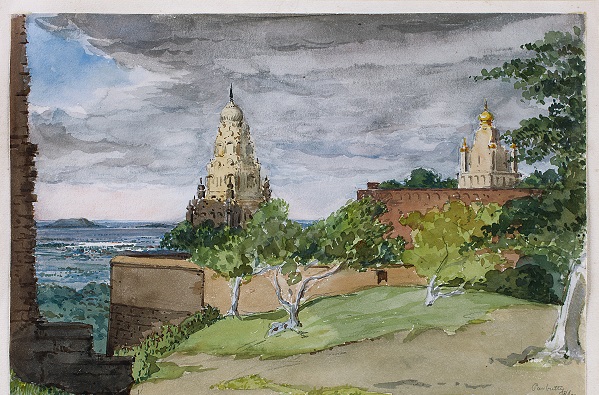
William Carpenter
Parbutty near Poonah (detail)
Watercolour on paper pasted on paper, 1850, 7.0 x 9.7 in.
Collection: DAG
|
Edward Lear (1812—1888) |
|
|

Edward Lear
Plains of Bengal, from above Siligoree
Watercolor with pen in brown ink and gouache on medium, moderately textured, wove paper, mounted on very thick cardboard, 1874, 11.5 x 17.1 in.
Image courtesy: Wikimedia Commons
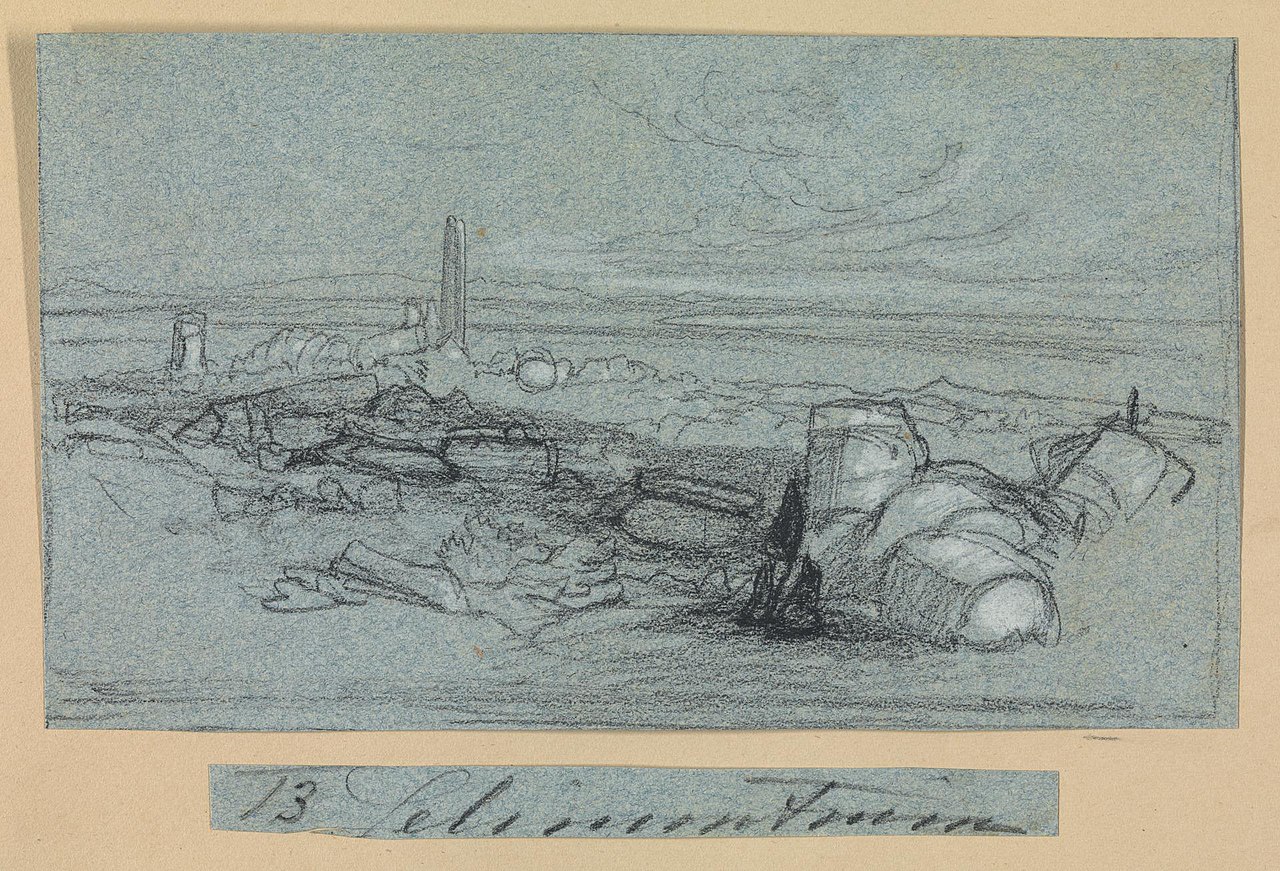
Edward Lear
Landscape Study with Ancient Ruins
Image courtesy: Wikimedia Commons
Edward Lear, an English artist and poet renowned for his limericks and nonsense verse, also made significant contributions to landscape painting, particularly during his travels in India from 1873 to 1875. His artistic journey in India is characterised by a distinctive style and a prolific output of watercolours and sketches that capture the country's diverse landscapes and cultures. During his time in India, Lear travelled extensively, utilising various modes of transportation to reach remote locations. His travels took him from bustling bazaars to quiet villages, where he immersed himself in the local scenery and culture. This experience allowed him to create a large body of work, including coloured wash drawings that he later transformed into oil and watercolour paintings in his studio. |

Edward Lear
The British Residency, Lucknow
Watercolour on paper, 1873, 3.5 x 6.5 in.
Collection: DAG
Lear's landscapes often feature strong sunlight and vibrant colour contrasts, reflecting the intense light and vivid hues of the Indian environment. His works from this period are not only artistic representations but also serve as historical documents that provide insight into nineteenth-century India. He captured a range of subjects, including architectural landmarks, rural scenes, and the natural beauty of the landscapes. According to some writers such as Kirby Olson, Lear can be called a ‘Deleuzian Landscape Painter’ (borrowing from the philosophy of the French thinker, Gilles Deleuze) and his works have been described as ‘an endless variation on a theme.’ His paintings are noted for their ability to evoke a sense of ‘becoming’ rather than static representation, embodying a dynamic interplay between form and movement. This approach aligns with Deleuzian philosophy, emphasizing multiplicity and fluidity in perception and expression—as can be seen in his depiction of the British Residency at Lucknow as well. Lear's landscapes thus not only document geographical features but also invite viewers into a transformative journey through landscapes that are both familiar and fantastical, echoing the imaginative spirit seen in his literary works. |
|
William Carpenter (1818—1899) |
|
|

William Carpenter
Parbutty near Poonah
Watercolour on paper pasted on paper, 1850, 7.0 x 9.7 in.
Collection: DAG
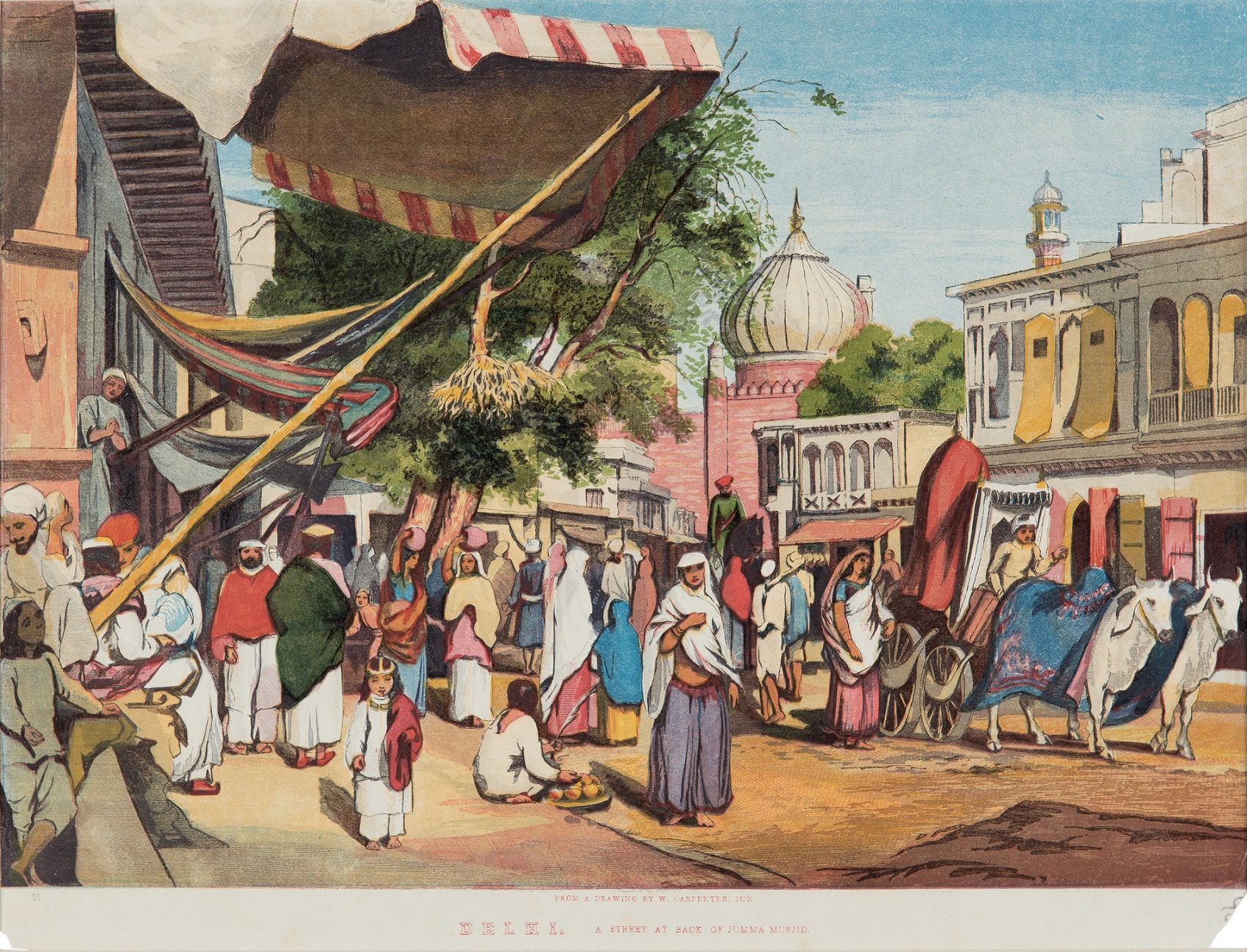
William Carpenter
Delhi. A Street at back of Jumma Musjid
Wood engraving on paper, 185 7, 8.7 x 12.2 in.
Collection: DAG
William Carpenter was a British watercolour artist who travelled extensively in India from 1850 to 1856, capturing the country's diverse landscapes, architecture, and people in his paintings. During his travels, which took him from Bombay (Mumbai) to Rajasthan, Delhi, Kashmir, Lahore, and Afghanistan, Carpenter created a large body of work that showcased his skill in depicting everyday street scenes, portraits, and architectural monuments. Carpenter's paintings are known for their accurate and animated depictions of people, as well as his ability to capture the character of his sitters and the effects of sunlight on cityscapes. His use of warm colours and a gentle romantic style evoke a sense of the spiritual nature of his subjects, as seen in his painting of the Jama Masjid. The ‘Jumma Masjid’, commissioned by Mughal Emperor Shah Jahan and completed in 1656, stands as a testament to Mughal architecture's opulence and craftsmanship. Simpson's paintings not only showcase the mosque's imposing structure, with its red sandstone and marble accents, but also convey the bustling atmosphere of the surrounding area. |
|
Charles W. Bartlett (1860—1940) |
|
|
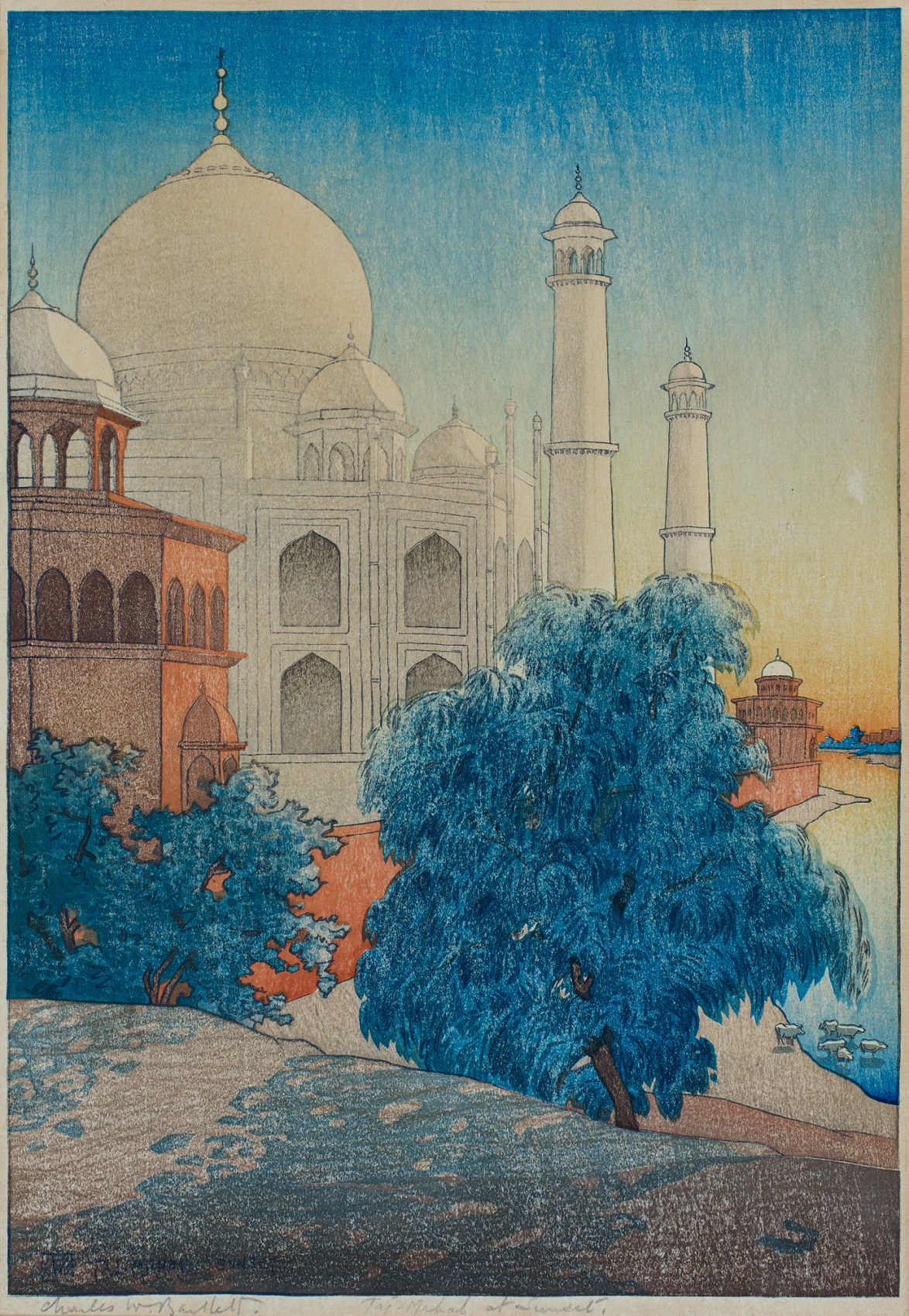
Charles William Bartlett
Taj Mahal at Sunset
Kokka woodblock print on paper, c. 191 9, 15.0 x 10.2 in.
Collection: DAG

Charles William Bartlett
Udaipur
Kokka woodblock print on paper, 1916, 8.7 x 12.0 in.
Collection: DAG
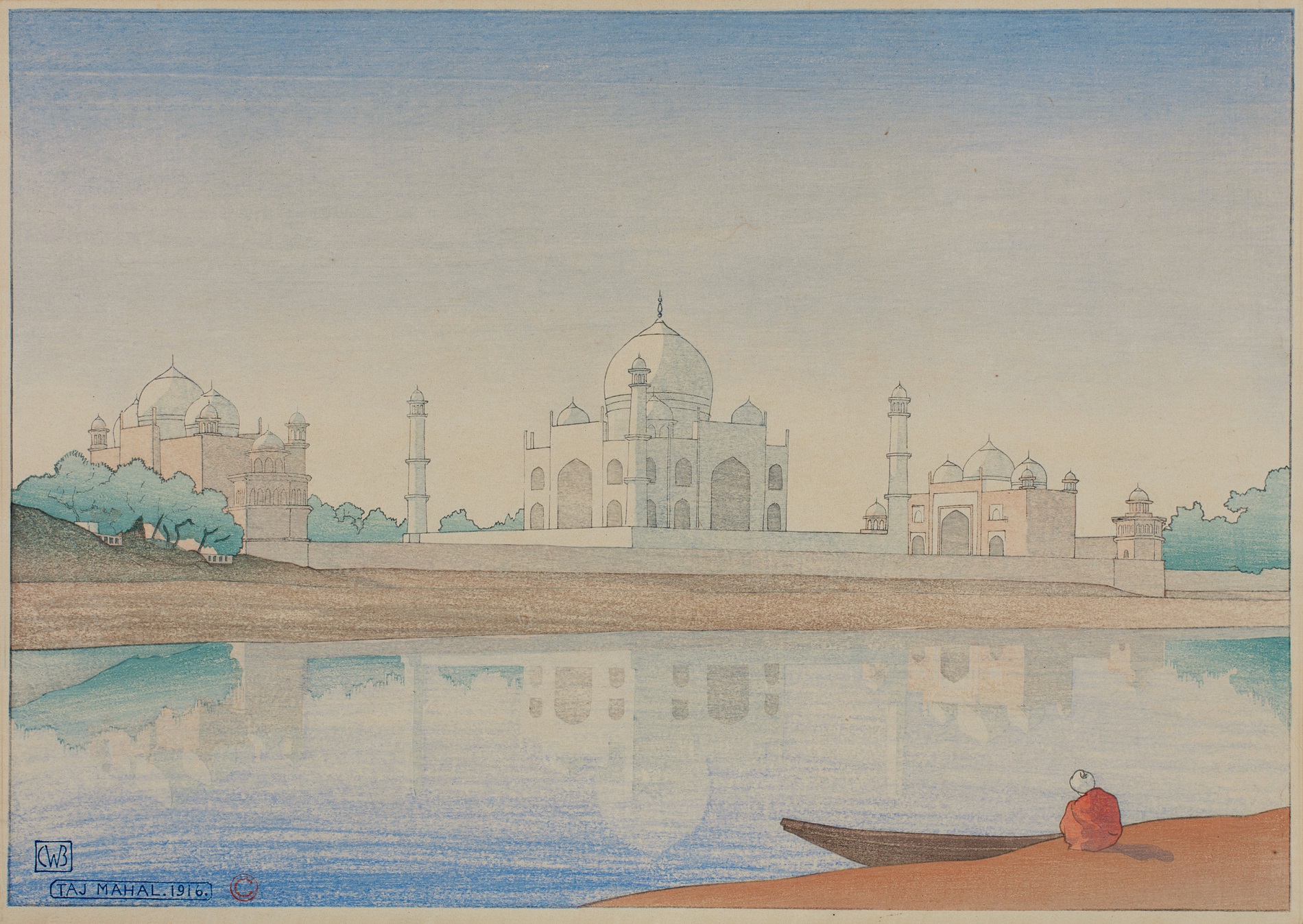
Charles William Bartlett
Taj Mahal
Kokka woodblock print on paper, 1916, 10.5 x 15.0 in.
Collection: DAG
Charles W. Bartlett was a British painter and printmaker who travelled to India in 1913 and collaborated with the Japanese woodblock print publisher Watanabe Shōzaburō to produce a series of woodblock prints depicting scenes from his travels. Bartlett's prints showcase his vision of India in the ‘shin-hanga’ style, which blended traditional Japanese ukiyo-e techniques with European influences. Watanabe published twenty-one woodblock prints from Bartlett's designs, including landscapes, people, and scenes of everyday life. Bartlett's etchings were hand-coloured with watercolour, resulting in prints with varied colours depending on his choices. Some of the notable locations featured in Bartlett's India prints include the Meenakshi Temple in Madurai, views of Mathura, the Taj Mahal at Agra, the ghats of Benares (Varanasi), and the lakes of Udaipur—anticipating and responding to some of the most iconic tourist destinations of India. |
|
Hugo Vilfred Pedersen (1870-1959) |
|
|
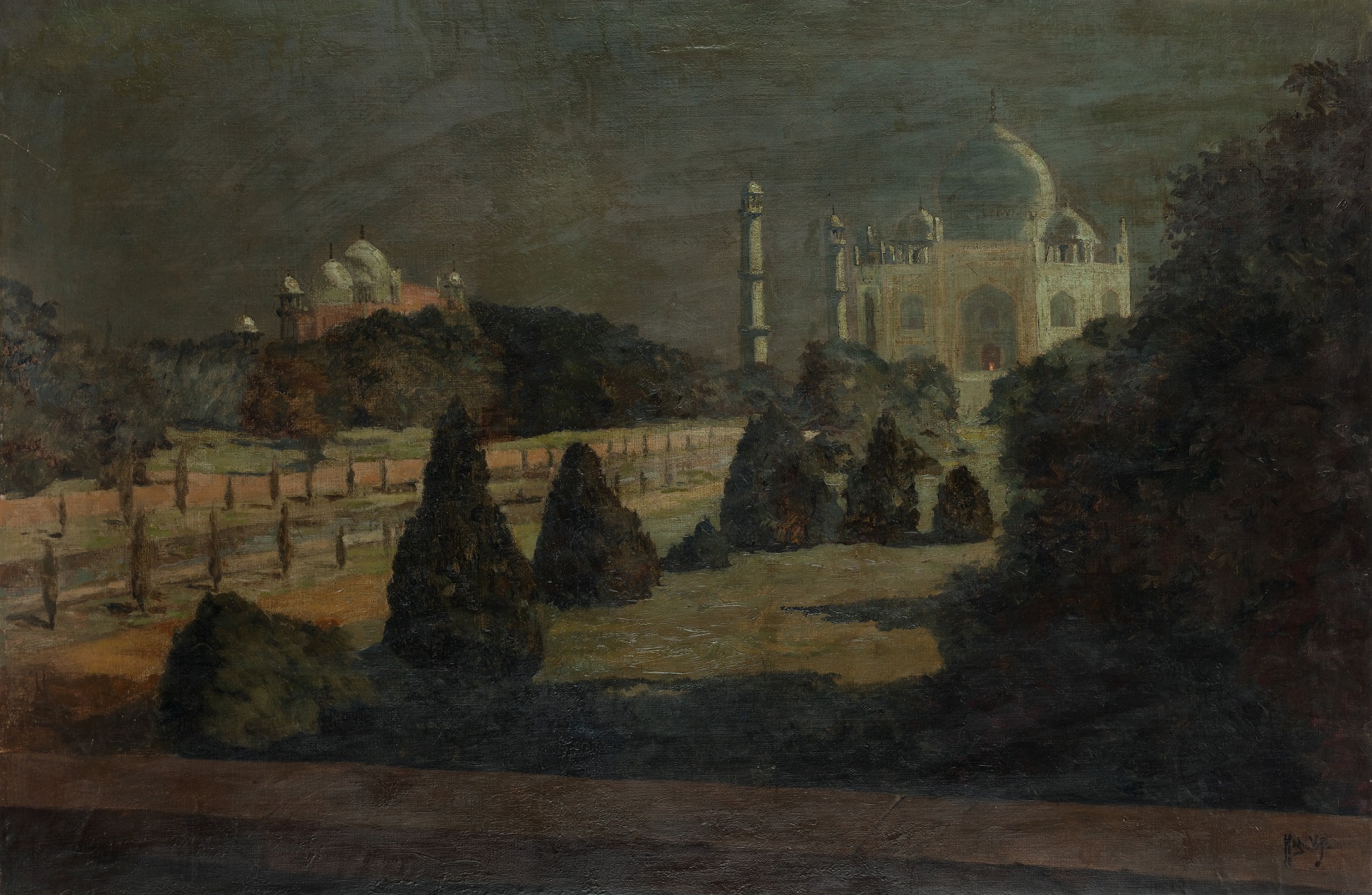
Hugo Vilfred Pedersen
The Taj Mahal in the Moonlight
Oil on canvas pasted on ply board, 23.5 x 35.5 in.
Collection: DAG

Hugo Vilfred Pedersen
Gate of the Arab Sarai in Delhi
Oil on canvas, 19.2 x 15.7 in.
Collection: DAG
Hugo Vilfred Pedersen was a notable Danish painter and illustrator, recognised for his contributions to portraiture, cityscapes, and architectural painting. He was a student of prominent artists B. Schröder and F. Henningsen, which helped shape his artistic style. Pedersen spent approximately twenty years traveling through India, where he created numerous portraits and landscapes. His works often featured prominent figures, including a notable portrait of the Maharaja of Burdwan and the Viceroy of India, Lord Curzon, during the Delhi Durbar in 1903. These portraits highlight his ability to capture the essence of his subjects, showcasing their attire and cultural significance. Pedersen's paintings are characterised by a traditional European style, emphasising detail and realism. |
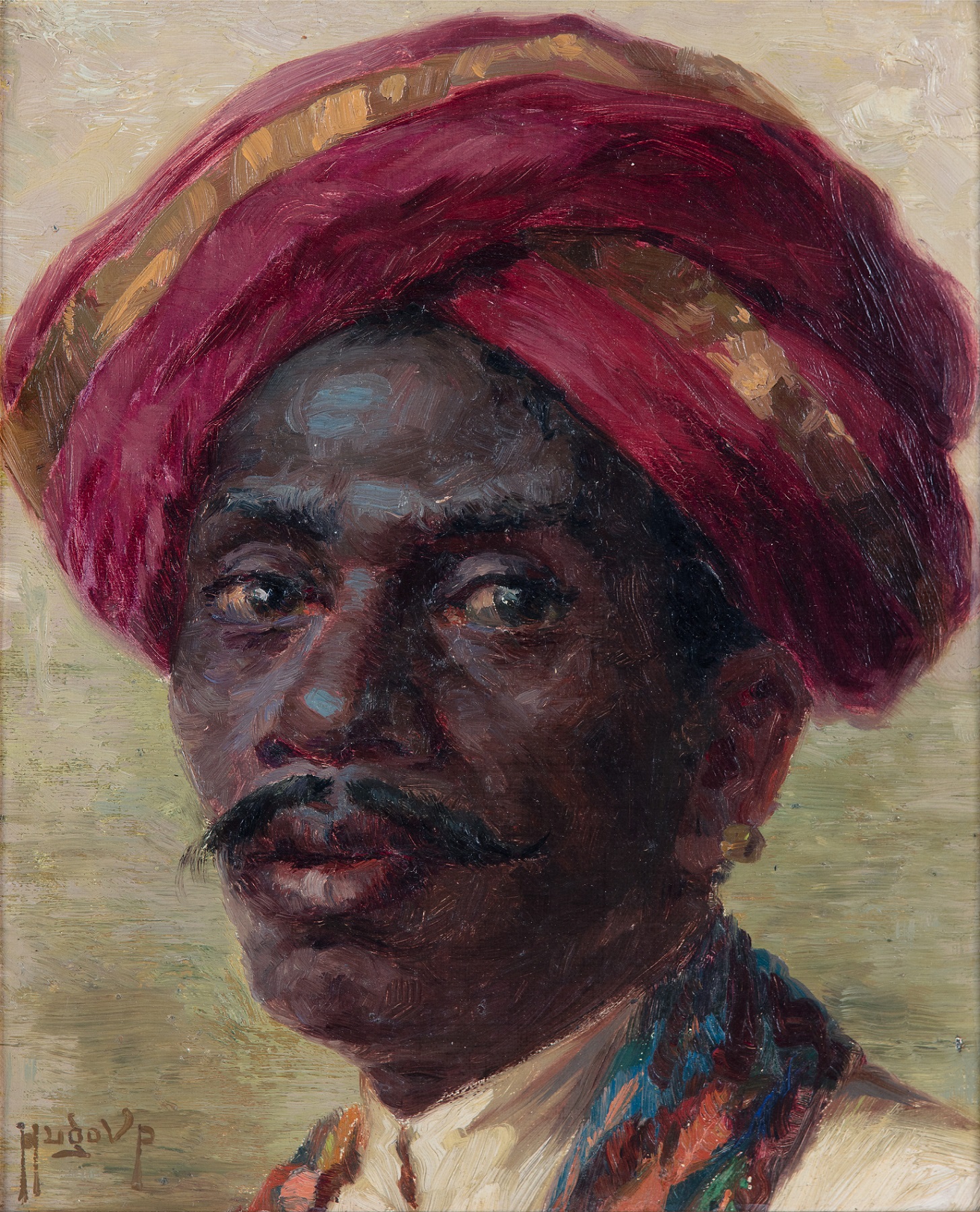
Hugo Vilfred Pedersen
Portrait of a Madras Boy
Oil on canvas, 11.7 x 10.0 in.
Collection: DAG
He employed oil on canvas to create vibrant and lifelike representations of his subjects. His focus was not only on the elite but also on ordinary people, including liveried servants and guards, which demonstrated his interest in the broader social context of the colonial environment. Pedersen earned the nickname ‘The Rajah Painter’ due to his popularity among Indian and European rulers, reflecting his status as a sought-after portraitist. His works have been recognised and published in various collections, including Peeps at Many Lands in 1926, which featured eight of his paintings. |
|
Ernest Stephen Lumsden (1883-1948) |
|
|
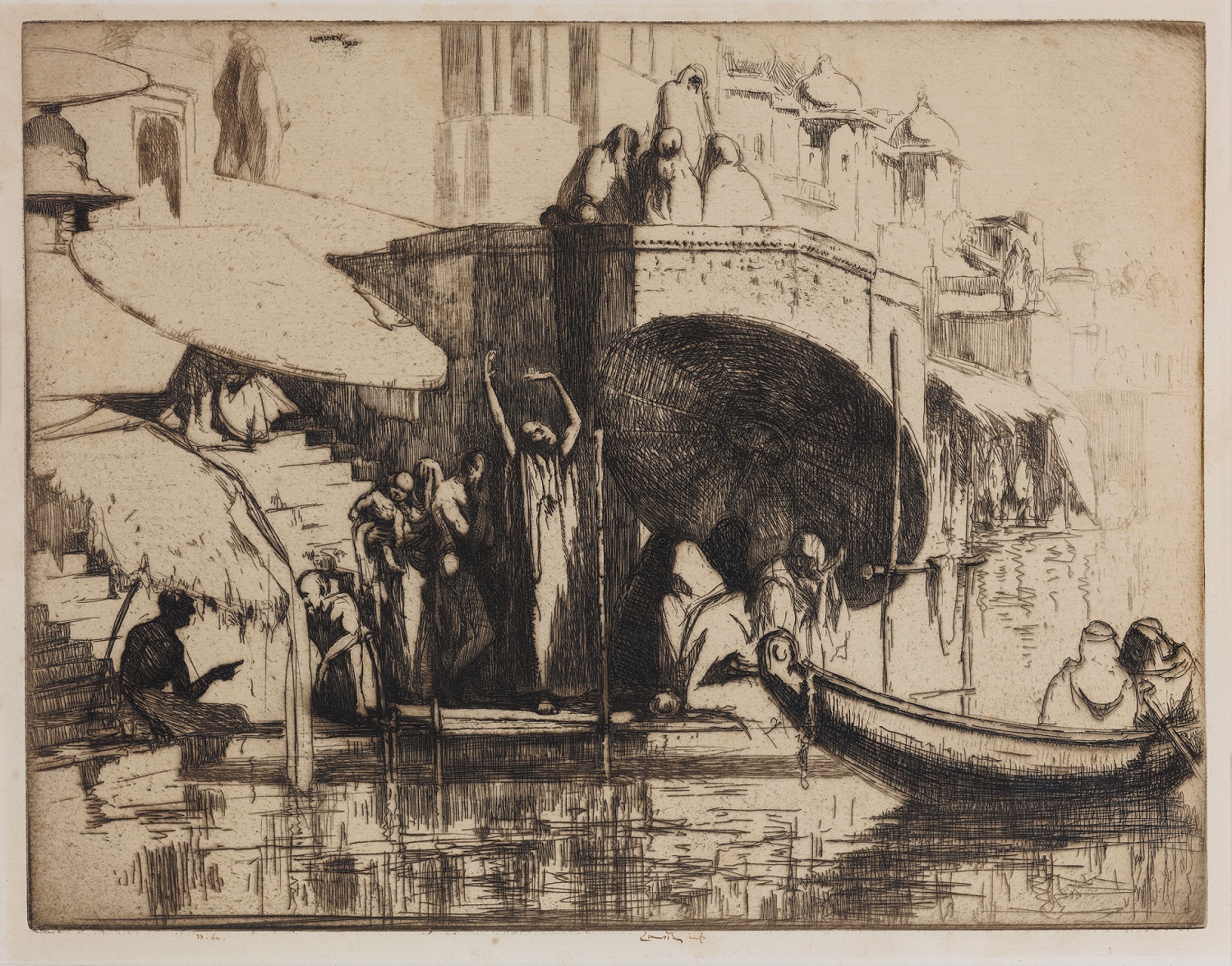
Ernest Stephen Lumsden
Benares
Etching on paper, 1920, 10.7 x 13.7 in.
Collection: DAG
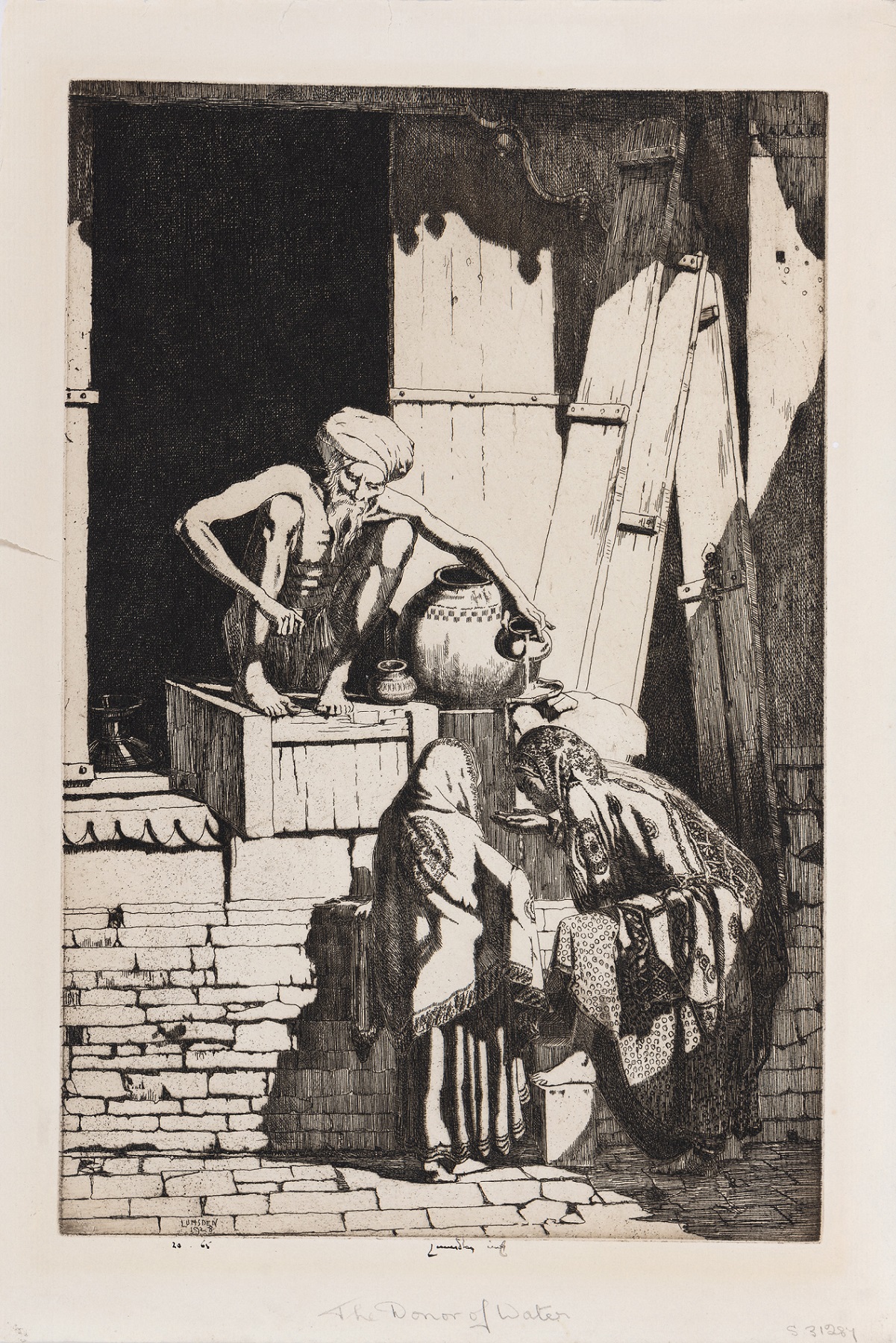
Ernest Stephen Lumsden
The Donor of Water
Etching on paper, 1928, 11.7 x 7.7 in.
Collection: DAG
Ernest Stephen Lumsden was a prominent British artist known for his exceptional etchings, particularly those depicting scenes from India. His artistic journey began in London, where he was born in 1883, and he later studied at the Reading Art School and briefly at the Académie Julian in Paris. Lumsden developed his etching skills largely through self-study, inspired by the technical guide of the nineteenth-century French printmaker Maxime Lalanne. Lumsden's fascination with India began during his travels between 1912 and 1927. He produced a significant body of work during this period, capturing the essence of Indian cities such as Benares (Varanasi), Jaipur, and Udaipur. His etchings often depicted the vibrant life along the River Ganges in Benares, showcasing both the architectural beauty and the cultural richness of the region. His repeated visits to India allowed him to create a diverse range of prints that reflected his deep appreciation for the country's landscapes and people. |
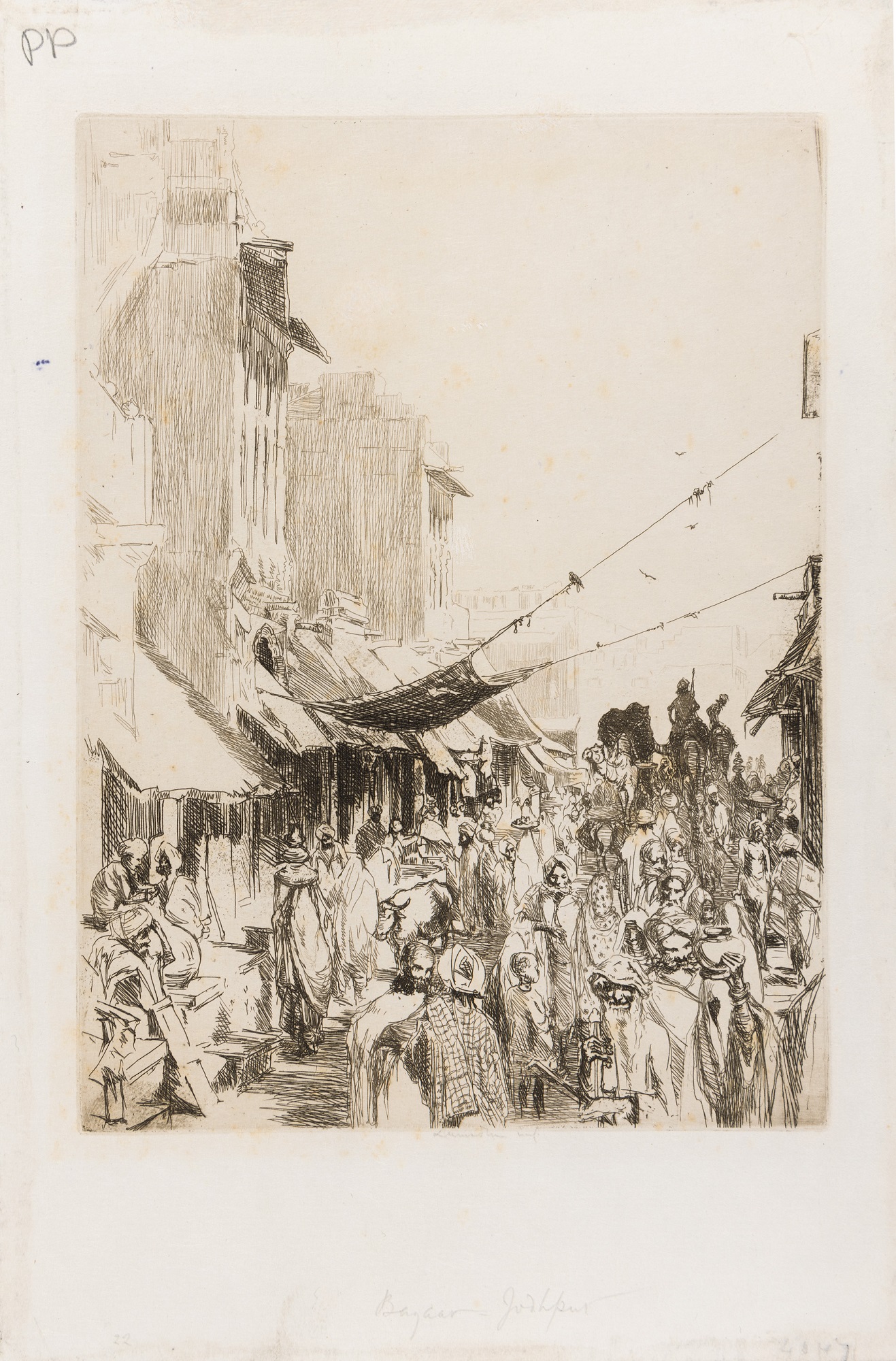
Ernest Stephen Lumsden
Bazaar – Jodhpur
Etching on paper, 6.5 x 4.7 in.
Collection: DAG
Lumsden was not only a skilled etcher but also a writer and educator. He published The Art of Etching in 1925, which remains a key reference in the field, detailing various techniques of intaglio printing and the historical context of etching. His work in etching was characterized by a meticulous approach, as he printed his own plates, ensuring the quality and integrity of his prints. |


